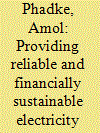|
|
|
Sort Order |
|
|
|
Items / Page
|
|
|
|
|
|
|
| Srl | Item |
| 1 |
ID:
132597


|
|
|
|
|
| Publication |
2014.
|
| Summary/Abstract |
Incentives are policy tools that sway purchase, retail stocking, and production decisions toward energy-efficient products. Incentives complement mandatory standards and labeling policies by accelerating market penetration of products that are more energy efficient than required by existing standards and by preparing the market for more stringent future mandatory requirements. Incentives can be directed at different points in the appliance×s supply chain; one point may be more effective than another depending on the technology×s maturity and market penetration. This paper seeks to inform future policy and program design by categorizing the main elements of incentive programs from around the world. We identify advantages and disadvantages of program designs through a qualitative overview of incentive programs worldwide. We find that financial incentive programs have greater impact when they target highly efficient technologies with a small market share, and that program designs depend on the market barriers addressed, the target equipment, and the local market context. No program design is inherently superior to another. The key to successful program design and implementation is a thorough understanding of the market and identification of the most important local obstacles to the penetration of energy-efficient technologies.
|
|
|
|
|
|
|
|
|
|
|
|
|
|
|
|
| 2 |
ID:
125424


|
|
|
|
|
| Publication |
2013.
|
| Summary/Abstract |
Televisions (TVs) account for a significant portion of residential electricity consumption and global TV shipments are expected to continue to increase. We assess the market trends in the energy efficiency of TVs that are likely to occur without any additional policy intervention and estimate that TV efficiency will likely improve by over 60% by 2015 with savings potential of 45 terawatt-hours [TW h] per year in 2015, compared to today's technology. We discuss various energy-efficiency improvement options and evaluate the cost effectiveness of three of them. At least one of these options improves efficiency by at least 20% cost effectively beyond ongoing market trends. We provide insights for policies and programs that can be used to accelerate the adoption of efficient technologies to further capture global energy savings potential from TVs which we estimate to be up to 23 TW h per year in 2015.
|
|
|
|
|
|
|
|
|
|
|
|
|
|
|
|
| 3 |
ID:
103477


|
|
|
|
|
| Publication |
2011.
|
| Summary/Abstract |
The Western Renewable Energy Zone (WREZ) initiative brings together a diverse set of voices to develop data, tools, and a unique forum for coordinating transmission expansion in the Western Interconnection. In this paper we use a new tool developed in the WREZ initiative to evaluate possible renewable resource selection and transmission expansion decisions. We evaluate these decisions under a number of alternative future scenarios centered on meeting 33% of the annual load in the Western Interconnection with new renewable resources located within WREZ-identified resource hubs. Our analysis finds that wind energy is the largest source of renewable energy procured to meet the 33% RE target across nearly all scenarios analyzed (38-65%). Solar energy is almost always the second largest source (14-41%). We find several load zones where wind energy is the least cost resource under a wide range of sensitivity scenarios. Load zones in the Southwest, on the other hand, are found to switch between wind and solar, and therefore to vary transmission expansion decisions, depending on uncertainties and policies that affect the relative economics of each renewable option. Further, we find that even with total transmission expenditures of $17-34 billion these costs still represent just 10-19% of the total delivered cost of renewable energy.
|
|
|
|
|
|
|
|
|
|
|
|
|
|
|
|
| 4 |
ID:
112259


|
|
|
|
|
| Publication |
2012.
|
| Summary/Abstract |
The objective of this paper is to analyze the effect on utility finances and consumer tariffs of implementing utility-funded demand-side energy efficiency (EE) programs in India. We use the state of Delhi as a case study. We estimate that by 2015, the electric utilities in Delhi can potentially save nearly 14% of total sales. We examine the impacts on utility finances and consumer tariffs by developing scenarios that account for variations in the following factors: (a) incentive mechanisms for mitigating the financial risk of utilities, (b) whether utilities fund the EE programs only partially, (c) whether utilities sell the conserved electricity into spot markets and (d) the level of power shortages utilities are facing. We find that average consumer tariff would increase by 2.2% although consumers participating in EE programs benefit from reduction in their electricity consumption. While utility incentive mechanisms can mitigate utilities' risk of losing long-run returns, they cannot address the risk of consistently negative cash flow. In case of power shortages, the cash flow risk is amplified (reaching up to 57% of utilities annual returns) and is very sensitive to marginal tariffs of consumers facing power shortages. We conclude by proposing solutions to mitigate utility risks.
|
|
|
|
|
|
|
|
|
|
|
|
|
|
|
|
| 5 |
ID:
166932


|
|
|
|
|
| Summary/Abstract |
In India, 46 million, mostly rural, households lack access to electricity – over 50% of those are in the states of Bihar and Uttar Pradesh. While India has set an aggressive goal of extending the grid to all households by 2019, grid extension does not necessarily imply reliable electricity access. Indian utilities face a financial disincentive to supplying reliable electricity in rural areas because of subsidized tariffs and low consumer willingness-to-pay. Tariff subsidies for full household electrification in these states would be about Rs 15,000 Cr per year, which is two-times the existing subsidies and equivalent to 20–30% of their annual utility revenues. We find that super-efficient lamps, TVs, and fans can reduce the energy consumption of a rural household by over 70% cost-effectively, resulting in a net reduction in the total subsidy burden. Reduced consumption offers an opportunity to raise consumer tariffs while ensuring consumers’ monthly electricity bills reduced. We also argue that super-efficient appliances make consumer-side storage cost-effective, leading to greater consumer willingness-to-pay. We recommend adoption of super-efficient appliances as part of the electricity access initiative in India, and electricity service based tariff setting as the next policy steps towards providing a reliable and sustainable electricity access.
|
|
|
|
|
|
|
|
|
|
|
|
|
|
|
|
|
|
|
|
|